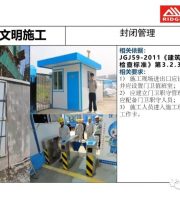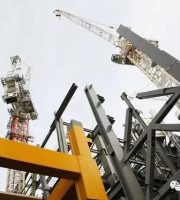1、 Preparation
.
1
.
Surveying and setting out
.
Establishment of temporary construction control network: in order to ensure the accuracy of pile location, the project plans to adopt the method of peripheral control network and site fixed point control network for construction survey and fixed point; 2
.
Pile casing setting and pile machine positioning( 1) The diameter of the punching pile is small, and the casing is generally made of 4-8mm thick steel plate with a height of 1.5-2m
.
The inner diameter of the casing of the punching pile shall be 100 mm larger than that of the drill bit
.
The top of the casing shall be provided with a slurry overflow opening, which shall be 0.15-0.30m above the ground( 2) Casing plays an important role in positioning, protecting orifice and maintaining water level difference
.
The position of pile casing shall be buried according to the center of vertical and horizontal axis according to the designed pile position
.
The pit for burying casing should not be too large
.
After the pit is excavated, the bottom of the pit shall be leveled, and then put into the casing
.
After the position is correct and the casing is vertical, the surrounding area shall be backfilled with clay, compacted layer by layer, and observed with the filling, so as to prevent the casing from shifting when filling
.
After the casing is buried, it shall be rechecked and corrected
.
The center of the casing shall coincide with the center of the pile position, and the deviation shall not be greater than 50 mm( 3) Buried depth of casing: not less than 1m in cohesive soil; It shall not be less than 1.5m in sandy soil, and the mud level in the hole shall be more than 1m higher than the groundwater level( 4) Positioning of pile machine: the cross crossing method is adopted by the pile machine for pile position, that is, the cross line is drawn on the set casing to make its cross point coincide with the stake, and then the machine is moved to position to make the action center of the steel wire rope of the pile machine coincide with the cross point( 5) After the pile machine is installed and positioned, it is necessary to carefully level the machine base, keep the three points of the turntable center of the crown block and the pile center in the same line, and then fix the punching machine to ensure that there is no deviation in the construction
.
3
.
Circulation system layout: in the whole construction process, the drilling hole adopts the self flow positive circulation system, and in the hole cleaning before the concrete pouring, the slag removal cylinder is used to remove the slag, so the circulation system layout is also divided into two parts: (1) self flow positive circulation system; Circulating pool shall be set in the construction site, and its volume shall not be less than 3m ³, The specific position is near the hole forming position, and the length of the ditch is not less than 3m, which is conducive to the sediment of the slag sample( 2) Slag removal: it is adopted in the hole cleaning stage before concrete pouring
.
4
.
Foundation treatment of drilling (punching) pile after foundation pit earthwork excavation: (1) foundation pit support and earthwork excavation are constructed from the previous bid section
.
After earthwork excavation, foundation treatment is carried out according to the actual situation of foundation geology on site, and roads must be built to the bottom of foundation pit( 2) Foundation treatment method: use 50 ~ 150 mm gravel (rubble) 500 mm thick for base treatment, while using the excavator to lay flat for back and forth compaction
.
5
.
Construction road setting: (1) according to the survey results, it is found that there are karst caves in the foundation of the project
.
During the construction of pile foundation, ground subsidence and collapse may occur at any time, so sufficient filling materials must be prepared( 2) In the process of drilling (punching) hole (karst cave) construction, it may cause hole collapse, ground subsidence and other phenomena
.
2、 Hole forming operation
.
Precautions for hole forming: (1) according to the engineering geological conditions, hole diameter and rock penetration, punching machine shall be used for hole forming of pile foundation of high-rise buildings in this project, and low hammer shall be used for hole opening( 2) In the process of flushing, the consistency of mud should be appropriately selected according to the geological conditions of each layer
.
At the beginning of flushing, as the surface backfill is easy to form mud, it can be flushed with clean water
.
After reaching a certain depth, the mud circulation flushing can be carried out( 3) In the process of flushing, pay attention to the change of stratum
.
For different soil layers, the mud concentration should be adjusted properly to form effective wall protection and prevent hole collapse( 4) To ensure the perpendicularity of the hole, it is necessary to check whether the base of the pile machine is stable and whether the wire rope coincides with the center of the hole
.
If the hole deviates, the block stone should be backfilled to repair the hole, and the hole can continue to be punched after ensuring that the hole is vertical( 5) After entering the bedrock, low hammer impact or intermittent impact shall be carried out
.
If partial hole is found, the rubble shall be backfilled to 300 mm ~ 500 mm above the partial hole, and then the hole shall be punched again( 6) When encountering Boulder, the high and low stroke alternate impact is adopted to break the boulder or strike it into the hole wall( 7) The hole shall be inspected every 5 m depth, and the hole shall be inspected before replacing the drill bit or at the place where the hole is easy to shrink( 8) After entering the bedrock, samples are taken every 300-500mm for non pile end bearing stratum and every 100-300mm for pile end bearing stratum
.
2
.
Judgment of rock depth and final hole
.
The judgment of the depth into the rock is the key control factor of the project and the main technical link related to the pile quality of the project
.
The judgment method of rock depth mainly refers to the design requirements, the buried depth of bearing stratum reflected by geological survey data, and the rock slag sample at the bottom of the hole
.
3
.
Verticality and pile hole diameter inspection
.
In order to ensure that the perpendicularity and diameter of the pile meet the design and specification requirements, after determining the depth into the rock, it is used on the pile hammer ф The 14 steel bar is welded to a circle with the same diameter as the pile, and then the pile hammer is put into the pile hole to move vertically up and down twice to scrape off the super thick mud attached to the hole wall of the pile, so as to ensure that the diameter of the pile meets the requirements
.
4
.
Hole cleaning
.
When the punching reaches the design depth, the punching should be stopped
.
At the same time, the mud should be pumped into the hole through the mud pump to replenish
.
The mud will naturally overflow, and the mud in the hole will be brought out by repeated circulation, and the specific gravity of the mud will gradually decrease
.
This process is called hole cleaning
.
When the mud gravity drops to 1.05-1.20, the viscosity is less than or equal to 28s, and the sand content is less than or equal to 8%, the hole can be delivered for acceptance after hole cleaning( 1) First hole cleaning: after the punch reaches the design depth, first lift the punch about 50 mm away from the bottom of the hole for slurry replacement and hole cleaning, and control the specific gravity of reflux slurry at about 1.30( 2) Second hole cleaning: before placing the reinforcement cage and pouring the concrete, the second hole cleaning shall be carried out with the slag bucket to ensure that the sediment thickness meets the design requirements
.
When the hole is cleaned for the second time, the slurry shall be changed continuously until the concrete truck is transported to the side of the hole pile or the concrete is pumped
.
After the properties of the sediment and slurry at the bottom of the hole meet the requirements, the concrete pouring preparation and underwater concrete pouring shall be started immediately
.
Before pouring concrete, the specific gravity of slurry within 500mm of hole bottom is less than 1.25, the sand content is not more than 8%, and the viscosity is not more than 28s( 3) During hole cleaning, it is necessary to check whether the sediment thickness at the bottom of pile, mud specific gravity and mud performance meet the specification requirements
.
When meeting the requirements, the hole cleaning shall be stopped immediately to prevent the hole wall from collapsing
.
The thickness of sediment at the bottom of pile is measured by standard rope, the specific gravity of mud is measured by hydrometer, and the viscosity is measured by viscometer
.
5
.
Allowable deviation of punching pile construction: (1) allowable deviation of pile diameter + 100, – 50( 2) The vertical allowable deviation is 0.8%( 3) Allowable deviation of pile position
.
6
.
Single pile, double pile along the vertical axis and side pile of pile group foundation: when the pile diameter is less than or equal to 1000mm, it shall not be more than 100 mm; When the pile diameter is more than 1000mm, it is not more than 100 + 0.01hmm; In the axial direction of double piles and the middle pile of pile group foundation, when the pile diameter is less than or equal to 1000 mm, it is not more than 150 mm; When the pile diameter is more than 1000mm, it shall not be more than 150 + 0.01hmm
.
3、 Reinforcement construction
.
Steel processing
.
The steel bar processing is completed in the processing yard set up on site, and the processing material list shall be strictly followed
.
If there is any error in the material list, it shall be corrected according to the normal procedures: (1) steel bar cutting
.
According to the different length of the specification steel bar, the overall layout, first cut the long material, then cut the short material, reduce the short head, reduce the loss
.
During material cutting, the steel bar cutting machine shall be installed stably, and the size scale mark shall be marked on the worktable, and the baffle plate for controlling the size of material cutting shall be set
.
In the process of cutting, if the fracture is found to have fold crack shrinkage head, serious elbow or horseshoe shape, it must be cut off.
.



